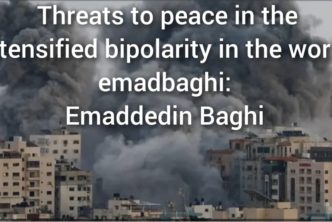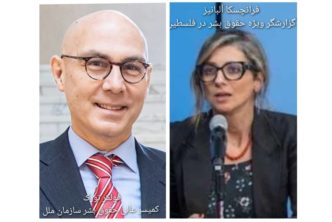By Ali Shirzadi,
On the Death Penalty in Iran, ” The Abolitionist Movement in Iran “pub: Together against the Death Penalty (Ensemble contre la peine de mort – ECPM) ,P 104 – 108Iranian journalist and filmmaker “Killing one person means killing an entire population. The killing of a human being is both the source and propagator of violence and has no relationship to kind-heartedness, a caring society, and the benevolence of the Creator. It is hence necessary to stop the spread of crime, felony as well as executions as soon as possible.”298
Introduction
One cannot address the issue of opposition to the death penalty and its application in Iran without taking into account the societal and political developments in the country, including those that affect civil society organisations. When considering that very few book reviews on the death penalty have been published in Iran, that public opinion is monitored and more concerned with economic and social issues which burden daily life and that there is no strong reaction from the intellectual elite about the application of the death penalty, can one really speak of an abolitionist movement in Iran? Who are the opponents of the death penalty who go against the ideals of Iranian political and judicial institutions? What kind of dialogue can civil society organisations opposing the death penalty expect to have with these authorities? Which vehicles must be used to raise awareness and to increase the significance and influence of associations without leading to confrontation with the Iranian government? These questions are the milestones of a realistic but also prospective train of thought on the necessary structuring of the abolitionist movement in Iran.
I. Key figures and activist groups against the death penalty in Iran
First of all, it is important to contextualise the sensitive issue of mobilisation for the abolition of the death penalty, and the forms it can take in Iran. In fact there is no opposing front to the death penalty as such, but only key figures that emerge. It is therefore difficult to speak about an organised and structured force against the death penalty in the country. The only activities organised in this area and arising from civil society are the result of the Association for the Right to Life (see Box III, p. 109), founded in 2005 by Emadeddin Baghi after his release from prison. The latter is also responsible for the creation of another organisation, the Association for the Defence of Prisoners’ Rights in Iran.299 Among the key figures in the fight against the death penalty in Iran are Dariush Forouhar300 and Hossein Bagherzadeh.301 H. Bagherzadeh is one of the oldest abolitionist activists who has expressed his views on the death penalty in many articles. A year ago, some influential figures with different backgrounds also agreed to form a group called Legam (lit. “bridle”): this group is quite popular and is composed of figures from the world of politics, art and human rights such as Simin Behbahani (writer and poet), Parvin Fahimi302 (human rights activist), Jafar Panahi303 (filmmaker), Babak Ahmadi (writer and translator), Fariborz Raisdana (economist and political activist), Mohammad Maleki (political activist and former president of the University of Tehran), Alireza Jabbari (writer and translator), Mohammad Nourizad304 (writer and filmmaker) and Esmail Moftizadeh (lawyer). Today, Legam ressembles more a think tank than a truely active organisation, it is nonetheless an interesting and innovative initiative in the framework of awareness in Iranian society on the issue of the death penalty through artistic channels.
II. Leverage and constraints met by the opponents of the death penalty in Iran
Once more it is necessary to discuss the socio-political specificities of the country to be in a position to consider useful leverage in favour of the abolition of the death penalty in Iran. In current Iranian society it would be more appropriate to use an information campaign as a last resort.305 More attention must be paid to the attempts to unite society (acceptance by mentality), to disseminate ideas that we believe are right about the Talion and the death penalty, through scientific and academic means and to promote an intellectual debate… all this accompanied by effective and concrete actions. We must trigger what Emadeddin Baghi calls a “change in the software”, i.e. a change of what is portrayed as a just punishment. Without an improvement in the way things are perceived, nothing will change in practice and behaviours will remain unaltered. In addition, politicising the issue of the death penalty does not favour the convicted. Sometimes the biggest favour one could do for them is not to be present in person, but rather to ensure another form of presence (more discreet, for example through intermediaries, if one’s presence could harm the convicted person). Sometimes an information campaign is also started by a particular group, or is perceived as such. Its targets are of an ideological or political nature and it has a persuasive effect with respect to the defence of human rights and the fight against the death penalty. It is extremely important to take this into account in an Iranian context where suspicion over this type of campaign is amplified. In this context, the cyber space is a double-edged sword, and exchanging messages is not in itself a positive and real opinion movement likely to truly fuel the socio-political debate in Iran. The constraints and harassment incurred by individuals who speak out in Iran against the application of the death penalty are an obstacle to the shaping of this opposition to the capital punishment. Some opponents of the death penalty who have expressed their views in the press have suffered numerous attacks from the regime and its supporters, such as Emadeddin Baghi after the publication in August-September 1999 of his article “Edam va Qisas” (“Execution and Punishment”). The article caused a scandal at the time and the newspaper Neshat which published it was closed down. The author was accused of apostasy306 and was imprisoned. The editor-in-chief and managing editor of the publication were also given prison sentences. Emadeddin Baghi is an emblematic figure of the abolitionist movement in Iran. He has devoted several studies to the death penalty, particularly a book on the abolition of the death penalty in accordance with Sharia and Iranian laws,307 and another on the issue of the execution of minors.308 He has based his writings on thorough study of the religious texts and comparative studies on the concepts of qisas, forgiveness, and alternative penalties, pondering whether traditional interpretation is compatible with the sociocultural context of contemporary Iran. In this way he has attempted an innovative interpretation of Islam that could promote remedial law309 in replacement of punitive law.
III. What kind of dialogue on the death penalty is possible in Iran between NGOs and state authorities?
No type of confrontation with the authorities is beneficial to actions in favour of human rights: in this case, efforts for the abolition of the death penalty. On the contrary, to defend themselves, the authorities will call into question the independence of these actions and will find links with political parties if not intelligence services. The only possible benefit of such actions would be to give the authors a kind of credibility as opponents to the authorities in the eyes of public opinion, especially outside the country. Based on experiences garnered by the association “For the Right to Life”, an independent civil organisation may very well act within the legal framework and meet representatives of the authorities while maintaining a critical attitude. Thus, this association was able to work with the reformative branch of the regime that sees no fundamental problem in it. It has also chosen not to go public regarding most of its actions: the authorities could indeed interpret this as a form of mockery and would react accordingly. The perception of dialogue with the Iranian authorities is a problem in itself since any exchange with the government in Iran is interpreted as a shift in favour of the political positions of the power in place. On the contrary, dialogue with the legal authorities to resolve problems is an adequate and useful initiative. This requires a new change in the way things are perceived.
Conclusion
The abolitionist movement must be better structured and organised in Iranian civil society. Until then, this movement will only take the form of ephemeral emotional waves without fundamental implications, and could even be counter-productive to the targeted objective. Campaigns against the death penalty are organised to cause a stir around cases of condemned prisoners, particularly in the press. But this mobilisation quickly gives way to disillusionment. Moreover, to cope with this situation, grass-roots activities must be developed and the empowerment of non-governmental organisations must be reinforced and favoured so that they can act as a safeguard against any authoritarian or repressive drift. This step is necessary before concentrating efforts on the Iranian political system. The abolitionist movement is therefore a big challenge in Iran. One must trigger citizen activism, put an end to activists’ isolation, raise awareness in the civil society and help it embrace the fact that individuals in their society enjoy a fundamental right: the right to life.
The Association “For the Right to Life”
This association is based in Iran where it is currently active. It was founded in 2005 by Emadeddin Baghi(310) and is supported by a number of lawyers and defenders of human rights. In order to not offend the authorities’ sensitivity, the association has chosen not to create a website. “For the Right to Life” aims to change the public’s and politicians’ opinions with respect to the death penalty in order to lay the foundations of a true social movement. In this context, the association pursues four objectives:
1. to help society and the judicial branch put an end to the vicious circle of violence and raise awareness as to the reduction of executions in society.
2. to criticise the prevalence of a culture of violence.
3. to conduct studies on the issue of the death penalty.
4. to try and persuade the plaintiffs not to ask for the execution of the guilty party or parties. These actions are implemented by five different committees, including a legal committee (responsible for providing support to death row prisoners), a support and forgiveness committee and a sociocultural committee (responsible for developing artistic actions to denounce violence and capital punishment). In addition to its activities on the domestic front, the association has also participated in international conferences. It has attracted the attention of organisations that defend and promote human rights abroad,(311) and maintains close ties with Together against the Death Penalty (Ensemble contre la peine de mort – ECPM).( 312)
The association “For the right to life” was able to continue its support to death row prisoners and the victims’ families after the events of 2009 and 2010 (various demonstrations in the country and executions of anti-governmental demonstrators), but with more restrictions.
298. Quotation from Emadeddin Baghi, see http://www.emadbaghi.com/archives/2008/12/000998print.php (in Farsi)
299. In 2005, this association received the Human Rights Prize of the French Republic.
300. Dariush Forouhar was murdered in November 1998 by agents of the Ministry of Intelligence and was not able to leave traces of his work.
301. See www.iranglobal.info/taxonomy/term/70 (in Farsi)
302. Sohrab A’rabi’s mother who was among the victims of the green movement in 2009.
303. Jafar Panahi started his career as an assistant to the filmmaker Abbas Kiarostami. The filmmaker then pursued his career by showing the inequality and the absence of freedom in Iranian society through his films: The Circle (Golden Lion in Venice) in 2000 and Crimson gold in 2003 (“Un Certain Regard” Jury Award in Cannes) were banned by the Iranian government. Offside (Silver Bear in Berlin) in 2006 was also banned. In 2009, Jafar Panahi was arrested by the authorities whilst protesting against Ahmadinejad. In 2010, the filmmaker was charged with propaganda against the Islamic Republic and was imprisoned. He was invited to Cannes to form part of the official jury but was retained by the Iranian authorities in the prison of Evin.
304. For more information, his website is available in English and Farsi at http://nurizad.info/?tag=mohammad-nourizad.
305. From a methodological perspective, it must be noted that there are only a few critical articles and interviews in Iran about information campaigns.
306. E. Baghi was condemned to 7 and a half years in prison. This sentence was reduced to three years on appeal. Since serving his prison sentence he has published numerous articles as well as three books devoted to the death penalty.
307. Haq e-Hayat (The Right to Life), Vol. 1
308. Idem, Vol. 2. Both volumes were translated into Arabic and were published through an Arab information network on human rights based in Cairo.
309. According to E. Baghi, this remedial law is found in the Koran and in the remedial nature of the qisas, particularly in the Surah “The Cow”, in verse number 179.
310. For more detailed information, see http://www.emadbaghi.com/en/
311. As can be read in Véronique Gaymard’s article, “Emadeddin Baghi, le combattant contre la peine de mort en Iran” [Emadeddin Baghi, the opponent of the death penalty in Iran], Radio France internationale, 12th June 2013, available in French at www.rfi.fr.
312. ECPM will publish Emadeddin Baghi’s next book.
. Ali Shirzadi (p 138)
Mohammad Ali Shirzadi is an Iranian journalist and filmmaker. In January 2012, he was imprisoned for five months in the notorious prison of Evin for filming an interview between Emadeddin Baghi and the Ayatollah Montazeri, which was broadcast on the Persian BBC in December 2009, shortly after the death of Montazeri. He was present at the 5th Congress against the death penalty in Madrid to represent the association “For the Right to Life” founded by Emadeddin Baghi.





